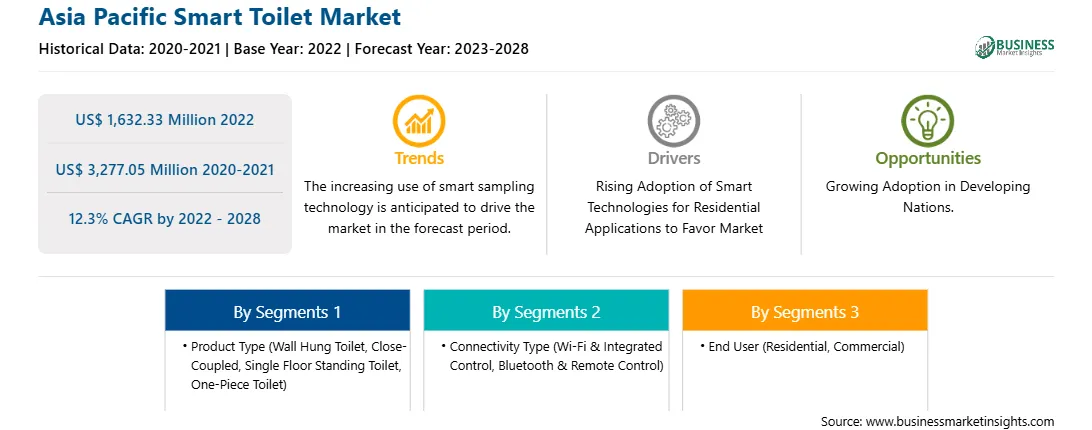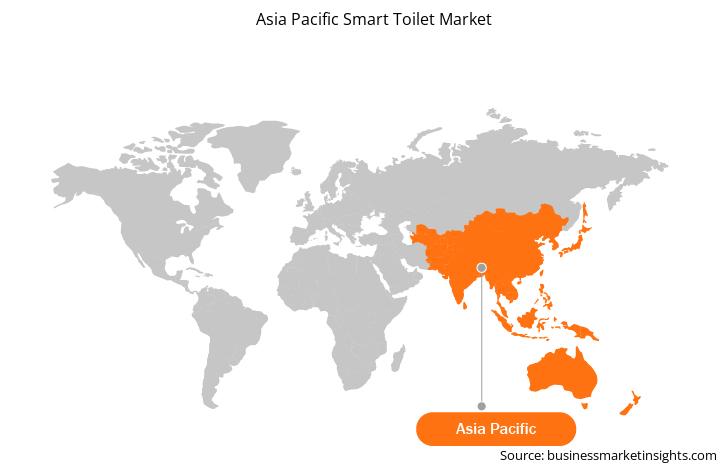Rising Adoption in Developing Nations Drives the Asia Pacific Smart Toilet Market
Rising need for conserving non-renewable resources, increasing disposable income of individuals in developing countries, growing environmental concerns, surging technological developments, and government regulations for water saving are bolstering the acceptance of smart toilets in developing countries. In India, Orissa is witnessing contracts for smart toilet construction at a bus stand. In Delhi, GARV Toilets are the stainless steel portable smart public bio-toilets integrated with a RFID-IoT powered mobile app that shows data on people using the toilet, availability of water amount, and the frequency of toilet cleaning. The rising adoption of smart cities is projected to boost the penetration of smart toilets in the coming period. The Government of India is investing US$7.3 billion in building 100 smart cities across India. The investment is predicted to improve sanitation facilities and make them smarter by installing restroom management solutions, smart toilets, and other technological products. Therefore, growing smart city initiatives and sanitation improvement projects in developing economies are expected to provide lucrative opportunities for the Asia Pacific smart toilet market growth during the forecast period.
Asia Pacific Smart Toilet Market Overview
The Asia Pacific (APAC) smart toilet market is segmented into Australia, China, India, Japan, South Korea, and the Rest of Asia Pacific. India, Malaysia, Singapore, China, and many other countries in the region are actively taking smart city initiatives for promoting the adoption of digitalization, automation, and the efficient use of resources such as energy and water. China and India, two fast-growing countries, have experienced a significant rise in urban population, coupled with their rising disposable income, over the years. According to data published by the World Bank, India experienced a rise in urban population by 2.32% in 2021. Moreover, 61% of the total population of China is now living in urban areas. According to the same source, the increasing disposable income and rise in technology adoption in China are further expected to boost the demand for smart toilets during the forecast period. The flush limit according to the Chinese government stands at 5.0 L or less. According to the Australian standard, the limit is 3.5 L or less. These limits are expected to increase the demand for intelligent toilets for ensuring the use of water as per the national standards in every flush. Thus, the increasing government initiatives to restrict the excess use of water in toilet flushes are expected to trigger the demand for smart toilets across APAC.

Strategic insights for the Asia Pacific Smart Toilet provides data-driven analysis of the industry landscape, including current trends, key players, and regional nuances. These insights offer actionable recommendations, enabling readers to differentiate themselves from competitors by identifying untapped segments or developing unique value propositions. Leveraging data analytics, these insights help industry players anticipate the market shifts, whether investors, manufacturers, or other stakeholders. A future-oriented perspective is essential, helping stakeholders anticipate market shifts and position themselves for long-term success in this dynamic region. Ultimately, effective strategic insights empower readers to make informed decisions that drive profitability and achieve their business objectives within the market.

| Report Attribute | Details |
|---|---|
| Market size in 2022 | US$ 1,632.33 Million |
| Market Size by 2028 | US$ 3,277.05 Million |
| Global CAGR (2022 - 2028) | 12.3% |
| Historical Data | 2020-2021 |
| Forecast period | 2023-2028 |
| Segments Covered |
By Product Type
|
| Regions and Countries Covered | Asia-Pacific
|
| Market leaders and key company profiles |
The geographic scope of the Asia Pacific Smart Toilet refers to the specific areas in which a business operates and competes. Understanding local distinctions, such as diverse consumer preferences (e.g., demand for specific plug types or battery backup durations), varying economic conditions, and regulatory environments, is crucial for tailoring strategies to specific markets. Businesses can expand their reach by identifying underserved areas or adapting their offerings to meet local demands. A clear market focus allows for more effective resource allocation, targeted marketing campaigns, and better positioning against local competitors, ultimately driving growth in those targeted areas.

Asia Pacific Smart Toilet Market Segmentation
The Asia Pacific smart toilet market is segmented into product type, connectivity type, end user, and country.
Based on product type, the Asia Pacific smart toilet market is segmented into wall hung toilet, close-coupled, single floor standing toilet, one-piece toilet, and others. The single floor standing toilet segment held the largest market share in 2022.
Based on connectivity type, the Asia Pacific smart toilet market is bifurcated into Wi-Fi & integrated control and Bluetooth & remote control. The Bluetooth & remote control segment held the larger market share in 2022.
Based on end user, the Asia Pacific smart toilet market is segmented into residential and commercial. The commercial segment held the larger market share in 2022.
Based on country, the market is segmented into Australia, China, India, Japan, South Korea, and the Rest of Asia Pacific. China dominated the market share in 2022.
Caroma Industries Ltd; Coma Intelligent Technology Co Ltd; Kohler Co; Lixil Corp; Ningbo Shunjie Sanitary Ware Co Ltd; and Roca Sanitario SA are the leading companies operating in the Asia Pacific smart toilet market.
The Asia Pacific Smart Toilet Market is valued at US$ 1,632.33 Million in 2022, it is projected to reach US$ 3,277.05 Million by 2028.
As per our report Asia Pacific Smart Toilet Market, the market size is valued at US$ 1,632.33 Million in 2022, projecting it to reach US$ 3,277.05 Million by 2028. This translates to a CAGR of approximately 12.3% during the forecast period.
The Asia Pacific Smart Toilet Market report typically cover these key segments-
The historic period, base year, and forecast period can vary slightly depending on the specific market research report. However, for the Asia Pacific Smart Toilet Market report:
The Asia Pacific Smart Toilet Market is populated by several key players, each contributing to its growth and innovation. Some of the major players include:
The Asia Pacific Smart Toilet Market report is valuable for diverse stakeholders, including:
Essentially, anyone involved in or considering involvement in the Asia Pacific Smart Toilet Market value chain can benefit from the information contained in a comprehensive market report.